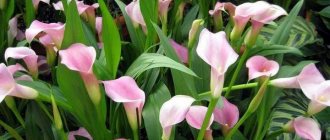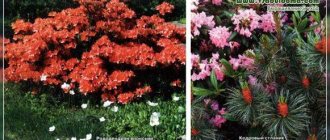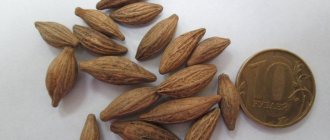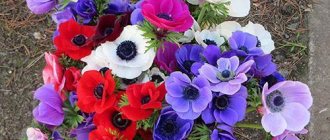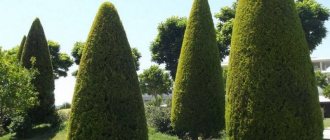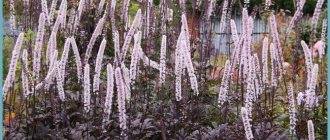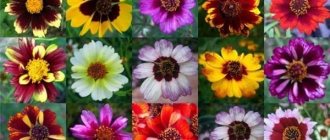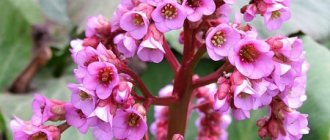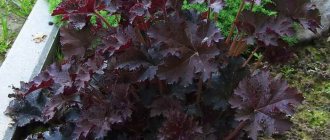Astrantia, or star, is a flowering plant from the Umbrella family. In nature, the culture grows mainly in the Caucasus and Europe. The exact origin of the genus name is not known. But the main version is that it comes from the words astron (star) and antion (opposite), which is associated with the shape of the flower, reminiscent of a star, and the covering leaves. The plant is very popular in America and England, where it has been cultivated since the 16th century.
Today, astrantia is widespread in different regions. Thanks to the work of breeders, many varieties have appeared that are successfully grown in household plots. This flower is absolutely undemanding in terms of keeping conditions; caring for it will not cause any trouble even for novice flower growers.
Types and varieties for open ground
The genus includes up to 40 plant varieties. Of these, only a few perennial species of astrantia are cultivated in open ground.
Large or big
The plant is up to 70 cm high. The stems are spreading, the leaves are 3-7 divided, forming a basal rosette. Inflorescences up to 5 cm in volume, pale pink. The species has been cultivated since 1597.
Popular varieties:
- Moulin rouge;
- Ruby Wedding;
- Claret;
- Sunningdale Variegata;
- Rosea.
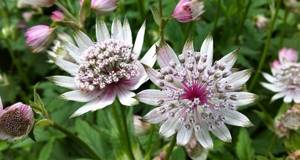
Greatest
The species is native to the Caucasus. This is a compact bush up to 70 cm high with a long rhizome. It has tripartite leaf blades, umbellate inflorescences with small pink flowers up to 4.5 cm in diameter. The involucre leaves are slightly reddish, up to 1 cm long.
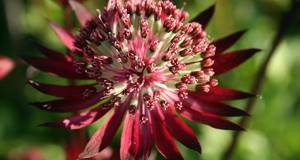
Small
The species has been cultivated since 1686. The plant is about 1 m high, with three to seven-part leaves located on long petioles. The flowers are multiple, white-pink, up to 3 cm in diameter. Flowering occurs in July-August.
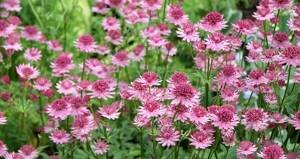
How to care for a flower
Any variety of astrantia can withstand high temperatures and practically does not need watering. Therefore, this plant is suitable for busy people who do not often visit their site. However, we must not completely forget about the flower.
Watering, fertilizing, pruning - all this will extend the life of the star. For the winter, you can cover young plants with spruce branches. Adult starweeds are cut off in the fall and are not covered.
Watering and soil care
If the summer is still too dry, then watering is done 1-2 times a week.
Pay attention to the top layer of soil: if it is too dry, then watering is needed more often
The peculiarity of astrantia is that if the soil is kept moist all days of the growing season, it can bloom again. After watering, you can loosen the soil or mulch. Humus is suitable as mulch.
Fertilizer
For the most part, large astrantia is presented on the market from seeds and seedlings, planting and caring for which does not require a lot of time and effort. With all its advantages, the star is responsive to fertilizers, like any plant.
It is worth adding organic fertilizers to the soil in spring or autumn. And when planting, you can add a small amount of green fertilizer (for example, legumes) or ammonium sulfate to increase the nitrogen content in the soil.
It is also recommended to add mineral supplements with the onset of the first warm days in spring.
Trimming
Pruning of astrantia is carried out at the end of flowering. The plant itself is not aggressive, but can easily spread by self-seeding. Therefore, it is better to cut off the inflorescences so that the star does not crowd out other plants. In early spring, cosmetic pruning can be done. In adult astrantias, the lower leaves are cut off. Thanks to this, you will prevent the occurrence of fungal diseases.
Growing from seeds to seedlings
Astrantia reproduces by seed. Many people prefer to sow seeds for seedlings. But in this case, the seed must be stratified. It is placed in the vegetable compartment of the refrigerator for 2-3 months before planting. Stratified seeds produce good seedlings.
Soil and container
Any containers are suitable for sowing - planting containers or boxes, plastic or peat cups. Prepare light, nutritious soil. Fill the containers with it. Spread the grains over the surface and compact them slightly. Sprinkle with a layer of substrate 1-2 mm thick. Cover the top of the crops with a transparent film and place in a warm place (+20..23°C).
Seedling care
After the seeds hatch on the surface, remove the film and move the containers to a well-lit place. Water the seedlings as needed. After the formation of 2 leaves, the seedlings are planted in separate containers. Use the same soil as for sowing seeds. You don’t have to pick the seedlings, but simply thin them out, leaving the strongest and healthiest specimens.
10 days before planting seedlings on the site, you can begin hardening. First, take the sprouts out onto an open balcony or loggia for a while, then outside. The duration of the procedure is gradually increased. At the time of planting, the seedlings should remain outside painlessly for the whole day.
Transplanting
Seedlings can be planted in late spring and early summer. The area needs to be well loosened and fertilized. But astrantia does not make any special demands on the soil. Seedlings are planted at a distance of 0.3-0.4 m from each other. Make holes of such depth that the seedlings in them are at the same level as in the planting container. Compact the soil around the planted plants and water them abundantly. Astrantia blooms from seeds only in the third year of life.
What does astrantia look like?
Astrantia bushes reach a height of 60-80 centimeters. The carved leaves of the plant serve as an additional decoration for flower beds; the leaves in the rosette are lobed, but the leaves sitting on the stem are shaped a little like carrots or parsley. This is not at all surprising, because astrantia belongs to the same family as carrots.
Before flowering, the bushes form a neat rosette of dense green leaves, which in itself looks good in a flower garden. At the beginning of summer, tall stems with peduncles appear from it.
The main value of the plant is its unique flowers. It is not easy for even an experienced gardener to guess that this is a representative of the umbrella family. The fluffy center, similar to many stamens, is actually an umbrella-shaped inflorescence that unites many tiny flowers, and the pointed “petals” framing it are bracts (involucre leaves).
This unusual appearance, which gives the flowers a resemblance to stars or fireworks, is a clever trick of nature to attract pollinating insects to small, inconspicuous flowers.
Depending on the variety, astrantias come in a variety of colors: burgundy, various shades of pink, white. In this case, the tips of the bracts always remain greenish.
“Wild” astrantia blooms single flowers of pale pink color, small (no more than 2.5 centimeters) in diameter, but in modern varieties you can find larger flowers, and their inflorescences are more numerous, due to which the total flowering period of this perennial increases.
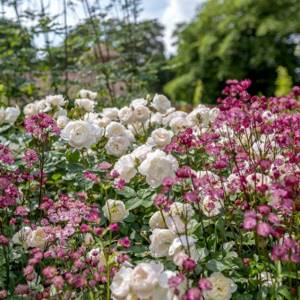
Astrantia is an ideal partner for roses. © dadu
Planting seeds in open ground
The flower can reproduce by self-sowing. But it is recommended not to leave this process to chance. It is better to collect seeds for subsequent planting or purchase the desired variety in the store. It is not necessary to first grow seedlings. Sowing directly into the ground is a less troublesome task.
Landing dates
It is better to sow freshly harvested seeds on the site in the fall. During the winter they will undergo natural stratification and produce more friendly shoots. In the spring they will only need to be thinned out. You can sow the seeds at the end of autumn, when the soil freezes a little. You can also sow in the spring, when warm weather sets in. But the seeds will need to be pre-stratified for 1-2 months.
Choice of location and lighting
Astrantia is one of the most unpretentious flower crops.
Although it loves sunlight, it can grow in a shaded place for a long time. On a note! If you choose a light area for Astrantia, the flowers will have brighter, more saturated colors. In partial shade, the petals become paler, but remain just as attractive.
Landing rules
Dig up the area in advance, fertilize it, and level it. Make indentations 3-5 mm. Place 2-3 seeds in them. Sprinkle with soil and water generously. The distances between the holes should be about 30 cm. After the emergence of seedlings, they need to be thinned out, leaving the strongest specimens. You can not throw away the seedlings, but transplant them to another place.
Choosing a planting site and caring for astrantia
Astrantia easily adapts to any level of light and grows well both in full sun (but with sufficient moisture) and in dense shade. However, in the latter case, the plant will have lush foliage, but you should not expect lush flowering. In full shade, the plant will produce only single inflorescences.
Ideally, astrantia should be grown where it can receive a few hours of morning sun and receive sparse sunlight throughout the day. In this regard, for better growth and flowering, astrantia should be planted in partial sun, for example, under the canopy of trees with a sparse crown.
Astrantia is an ideal perennial for the middle zone. The flower easily withstands harsh winters and is able to adapt to a wide range of growing conditions in many regions. However, in the South, where there is too high or, on the contrary, low soil moisture in combination with high temperatures, the flower will not be able to fully develop.
As for the type of soil, astrantia can easily grow on heavy clay soils, but in general this crop prefers slightly acidic, loamy soils that retain moisture well, but at the same time have sufficient drainage. It is best to prepare fertile soil for the plant with sufficient organic nutrients.
This flower does not tolerate stagnant water, so there should be no accumulation of spring melt water in the place where astrantia is planted. At the same time, the plant is very moisture-loving and will not survive long periods of drought. Astrantia should be watered regularly and thoroughly to maintain even soil moisture.
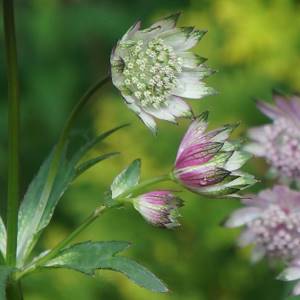
The tips of the bracts always remain greenish. © Lyudmila Svetlitskaya
Outdoor care
Growing astrantia on the site is very simple. Everyone can cope with this task.
Watering and loosening the soil
If there is enough rain in the summer, there is no need to additionally water the flowers. But even in dry and hot weather there is no need to worry too much. Zvezdovka is quite drought-resistant. If there is no rain, then you only need to water the plant once a week. But if you want to achieve repeated and longer flowering, then it is advisable to keep the soil moist throughout the growing season.
After watering, be sure to loosen the soil around the astrantia and remove weeds. To save time and prevent the soil from drying out, you can mulch it with peat or humus.
Feeding and fertilizer
If the crop was planted in fertile soil, then it only needs one fertilizing with complex fertilizer in early spring. If the area is poor in nutrients or the flower has been growing in one area for more than 3 years, then it should be further fed with a phosphorus-potassium mixture in the second half of summer. It is preferable to use liquid fertilizers. But if preference is given to dry ones, then after distributing them over the soil surface, you need to water them so that they are better absorbed.
Trimming
To avoid self-seeding, you need to remove faded flowers in time. After the first flowering, cut off all flower stalks. This procedure is necessary to stimulate the appearance of new inflorescences. It also makes the plant bushier and more symmetrical.
The benefits of astrantia as a perennial
In addition to its original appearance, this rare flower has many other positive aspects that contribute to the plant becoming more widespread.
The flowering time of astrantia is from June to August, and in some varieties there is a second wave of flowering - in September. This is not only a worthy decoration for flower beds, but also a godsend for florists, because astrantia lasts a long time when cut (up to two weeks when fresh) and forms original combinations with other flowers.
Astrantia is also good as a dried flower, since it, like all umbelliferous plants, retains its shape perfectly. Cutting astrantia inflorescences promotes longer flowering.
Astrantia is a good honey plant and, with its wonderful honey aroma and the appearance of its inflorescences, attracts many insects to the garden. Thanks to astrantia, colorful butterflies will always be present in your garden, because it is very difficult for winged beauties to resist the attractive power of this flower.
This perennial is a hassle-free plant that is suitable for busy gardeners if you choose the optimal planting location for it from the start. The only requirement for astrantia is regular watering during drought. But pests and diseases usually avoid this flower.
Astrantia will grow in one place for a long time without transplanting and will delight you with its regular flowering. Over time, the bushes will grow in width, but the plant is not aggressive, maintains a compact shape and does not interfere with its neighbors in the flower garden. This perennial is quite tall, but its dense stems will not require staking.
Astrantia winters well without any shelter. And it will develop well and withstand winters in regions belonging to zones 4-9. That is, this perennial is absolutely resistant to the climatic conditions of the middle zone.
Being a plant with a romantic appearance, this flower is an ideal option for natural-style gardens, mixborders and shady flower beds. But, in principle, astrantia is universal and can find a place in any garden.
Dark-colored varieties of intricate “jagged” flowers will add a little mysticism to the garden, while pink stars, on the contrary, will add a romantic mood. Mass plantings of astrantia will look most impressive.
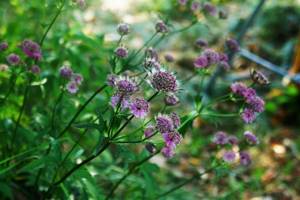
Dark-colored varieties of intricate “toothed” flowers will add a bit of mysticism to the garden. © Lyudmila Svetlitskaya
Protection from pests and diseases
Astrantia has a strong immune system, so it rarely gets sick and is susceptible to pest invasion. Sometimes it can be affected by naked slugs. They feed on leaves and spoil the appearance of the plant. They need to be collected by hand and destroyed. To protect against these pests, you can use the chemical "Thunder".
If starweed grows in heavy, acidic soil and suffers from excess moisture, its roots may rot. In such cases, it is necessary to regulate watering. Treat the affected plant with a fungicide (Quadris, Fitosporin). In case of prolonged rains, provide an additional drainage system for water drainage. Regularly loosen the soil around the bush.
Planting astrantia
Before planting astrantia, you must first inspect the area of the site. These unpretentious flowers like a sunny place, as well as partial shade.
There are varieties that can easily grow in the shade, but the umbrella flowers in this case will be small. The bushes will grow low and compact.
Soil preparation
Astrantia are one of those perennials that you don’t have to worry about planting in special soil. Ordinary soil is quite suitable for them, which will not be too depleted and dense.
The soil should be at least somewhat fertile, but there is no need to specially improve it.
Landing Features
When planting astrantia, it is important to maintain a distance between plants, which should be from thirty to forty centimeters. As for the depth and size of the planting holes, they are indifferent to astrantia
To plant it, it will be enough to dig small holes, and there is no need to lay drainage
As for the depth and size of the planting holes, they are indifferent to astrantia. To plant it, it will be enough to dig small holes, but there is no need to lay drainage.
Astrantia begins to bloom in the third year after planting.
Next, you need to install the seedling in relation to the ground at the same level as it was in the pot or container, and then simply cover it with soil, lightly compacting it.
Immediately after planting, do not forget to water the plant abundantly. Planting from seeds in the fall also needs to be thinned out in a timely manner.
If you follow these simple rules, then astrantia will be able to actively begin to grow and bloom in the third year.
From the second year, the bushes of the plant, which were planted at the optimal distance, will be able to close together and create nice continuous thickets.
Reproduction
Astrantia propagates well from seeds. But with this method, the maternal characteristics of the plant are not completely preserved. Therefore, for varietal flowers it is better to use vegetative propagation. The most effective is dividing the bush. The procedure is carried out in the spring, but some gardeners practice division in late autumn. The bush is dug up and the root nest is divided into sections using a sharp tool. The cut areas are treated with charcoal. The divisions are planted in separate holes at a distance of 30-50 cm from each other. It is recommended to put a little humus in each hole for fertilizer. Flowering on bushes from divisions occurs 2-3 years after planting.
Reproduction of astrantia
Vegetative propagation of astrantia is no different from the division of any perennial plants. The culture tolerates dividing the bush well, especially in spring, but dividing perennial astrantia bushes in late autumn is also often practiced. When the cuttings are separated, the mother astrantia bush rejuvenates and blooms more luxuriantly the next season.
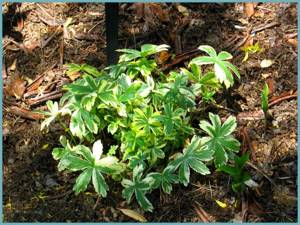
The easiest way to propagate astrantia is by dividing the bush. Astrantia should be planted only with fresh cuttings, then the plant will take root more easily and develop better.
Astrantia seeds are sown directly into the soil in a permanent place allocated for the plant. Sowing of seeds is carried out in the fall, in pre-prepared beds.
Astrantia in landscape design
More often, the plant is planted in groups in flower beds, ridges, and mixborders. Flowers look harmonious with other perennials:
- geranium;
- lungwort;
- heuchera;
- astilbe.
You can create a separate flowerbed from different varieties of astrantia. Given the unpretentiousness of the plant, it is planted near tall shrubs and trees, giving the landscape of parks and gardens a decorative appearance. Low-growing varieties look good near artificial ponds, rock gardens, and rocky gardens.

Astrantia is an attractive plant that is loved by many gardeners for its unpretentiousness and ease of care. Unlike many flowering plants, it can grow almost anywhere and can withstand shade and drought. Modest pastel star flowers can decorate any landscape, both in single plantings and in groups with other plants.
More useful information about growing Astrantia from seeds, as well as about the features of growing flower crops, can be found after watching the video:
Use in garden design
Astrantia is a plant that seems to have been created by nature itself for charming landscape lines and natural plantings, but the use of this perennial in landscape design is by no means limited to landscape trends and styles.
- Astrantia is great for use both in single plantings and in spectacular groups. In group plantings, astrantia is most often used to decorate the lawn and create mixed garden beds, less often in compositions in traditional flower beds.
- This delicate plant goes well with large stones, so it can also be used when decorating rockeries.
- This perennial is very effective as an undergrowth of a shrub row or group, and also as a filler of clearings between light-transmitting trees and shrubs.
- This plant can even be used on the banks of streams and ponds, where the coolness stimulates more active formation of lush foliage.
Landing
Site selection and soil preparation. Zvezdovka is a light-loving and at the same time quite shade-tolerant plant. It can grow under trees and bloom profusely and for a long time. However, the optimal growing location is open areas with light partial shade. The more light, the brighter the colors of Astrantia flowers will be.
It is not too demanding on soil fertility - ordinary garden soil will do. On heavy loams, the site for planting Astrantia is prepared more thoroughly. 1 part sand, 2 parts humus and the same amount of soil are added into a small depression (depth and diameter up to 40 cm). On sandy slopes, only humus is used.
As neighbors you can choose astilbe, lungwort, sedum, ferns, hostas, loosestrife, and bells.
Reproduction and planting. The perennial is propagated in several ways - by cuttings, dividing rhizomes and seeds.
To obtain a crop that completely repeats the varietal characteristics of its predecessor, cuttings are used. The raw materials are root rosettes, which take root within a month. At the end of this time, new Astrantia seedlings can be planted in open ground. This can be done both in spring and autumn. At the same time, the mother bush rejuvenates and blooms more luxuriantly the next season. When planting Astrantia, it should be taken into account that it is quite large in size. Therefore, it is necessary to leave a distance of about 50 cm between the bushes. As for the depth of the planting holes, it is not important for the perennial. Simply place the seedling in the hole and then cover it with soil to hide the roots, pressing down lightly. No drainage system is required. Immediately after planting, the cuttings should be watered generously.
Reproduction by dividing the rhizome is carried out in late autumn, after the leaves die, or in the early spring - before they awaken. It is advisable to plant the roots in light and fertile soil. The first rosette of leaves will appear in the first year of planting. During the same period, Astrantia also forms flower stalks. In the second year, the perennial will form lush bushes that will need to be replanted after 5-7 years. If this is not done, then their decorative effect will decrease.
Propagation by seeds always gives good results. Planting material can be purchased on the market, or collected independently. In the latter case, bushes that are at least 3-4 years old are used. There are about 30 seeds in one umbrella, but only 3-15 of them are viable (depending on growing conditions).
When sowing in spring, hybrid and purchased seeds are pre-stratified (stored in the refrigerator for 3-5 weeks). Then they are sown in boxes with moist and loose soil and placed in a cool place for a month. After the first shoots appear, the containers are transferred to a bright place. If necessary, grown seedlings are thinned out or pruned. A distance of 7-10 cm should be maintained between the remaining plants. In May, Astrantia is planted in open ground.
Also, good results are ensured by sowing seeds immediately in a permanent place. This is done in mid-autumn, as soon as the ground freezes (in particular, late October - early November). This provides the planting material with natural stratification. The distance between seedlings is 15-40 cm, the depth of planting seeds in the soil is 2 cm. In both cases, the perennial planted with seeds for the first time blooms after three years.
